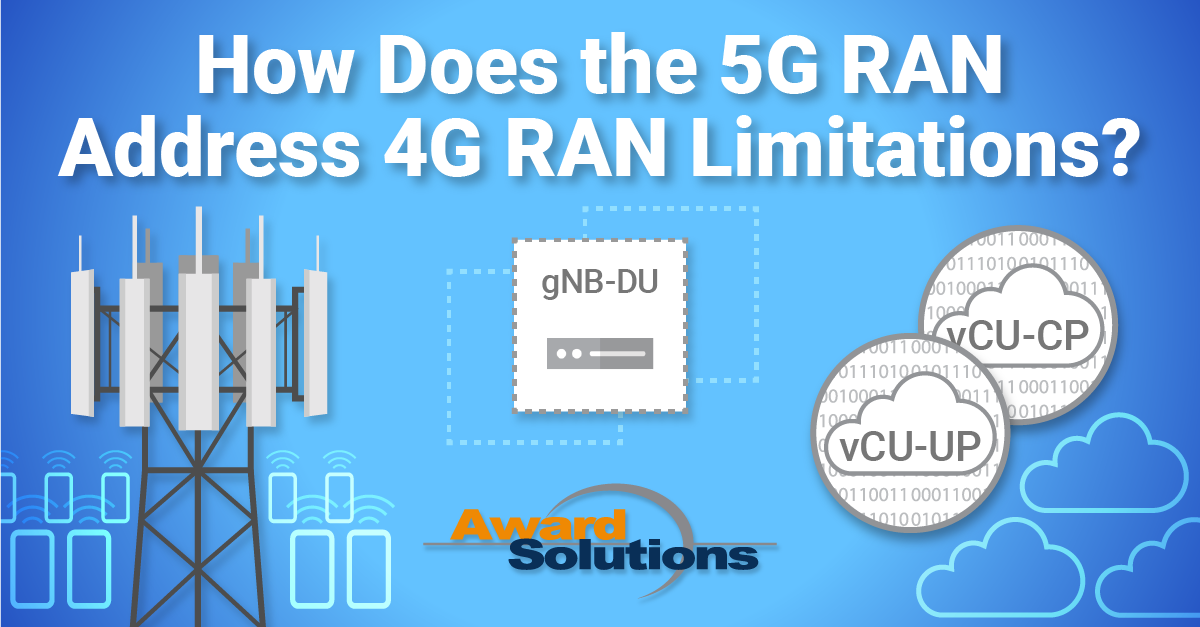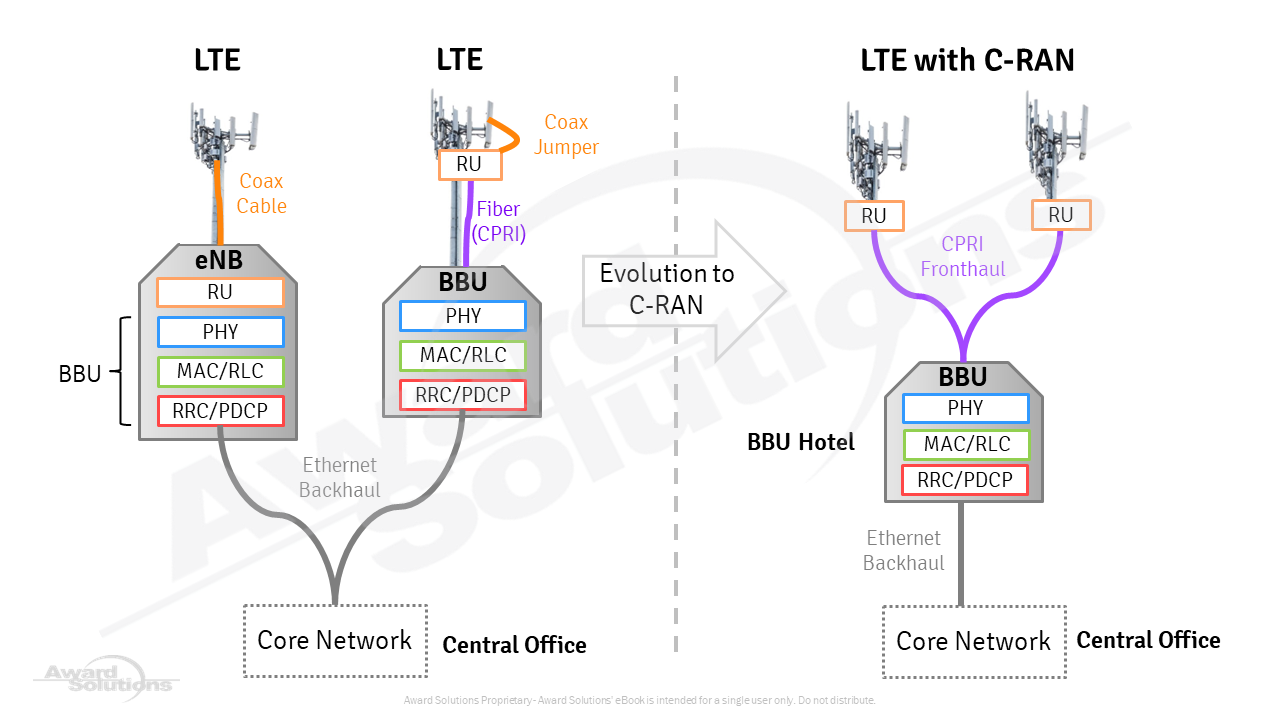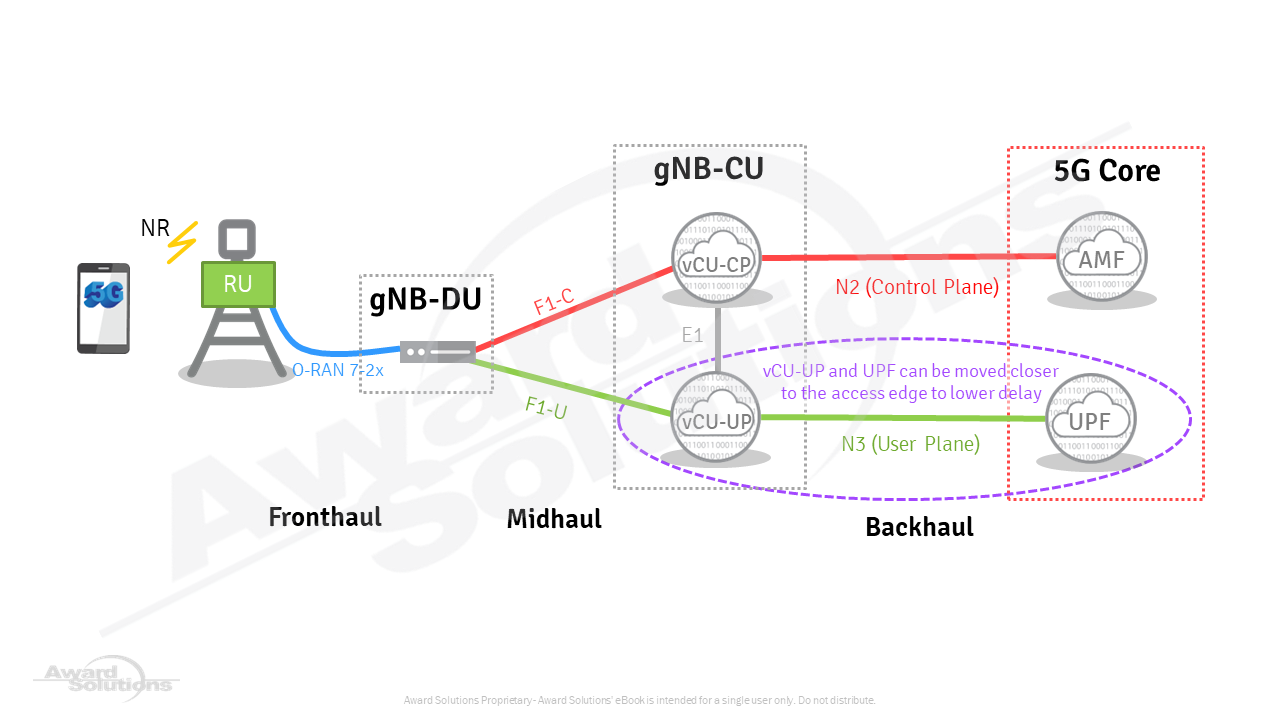
LTE networks and the Radio Access Network (RAN) deployment have evolved over the past decade. Initially, the Baseband Unit (BBU) at the heart of the RAN was deployed at the cell site – co-located with the radios and the antennas. Radio units (RUs) were eventually placed at the top of the tower next to the antennas to reduce coaxial cabling losses. Finally, for cost savings, operators aggregated BBU resources for many cell sites at a single location, so processing could be shared, allowing tighter coordination across cells. However, due to transmission delays, this approach is limited by transport bandwidths between the BBUs and RUs and fiber distance limitations. In addition to addressing use cases for low latency, Gbps throughputs, and network slicing, wireless network standards for 5G addressed some issues with 4G RAN.
4G RAN and Its Challenges
A typical eNodeB deployment for 4G RAN includes a Baseband Unit (BBU), a Radio Unit (RU), and antennas. The antenna connects to the RU with coaxial cables. The RU is joined to the BBU using a fiber connection called the fronthaul on the Common Public Radio Interface (CPRI) – typically running at 1 Gbps. Depending upon the operator's needs and the availability of fiber connectivity, the BBU can be co-located at the cell site or at a more central location called CRAN (Centralized RAN), where it can serve multiple geographically diverse cell sites. Finally, the BBU is connected to the 4G core network over Ethernet and is called backhaul.

Some challenges of the eNodeB architecture include:
- Bandwidth and Distance Limitations on the Fronthaul: To support up to 10x higher data rates for 5G on the fronthaul requires over 10-100 Gbps. Also, to keep latency low for applications like AR/VR and mission-critical apps, time-critical processing must happen near the antenna/RU, restricting how far the BBU is from the cell site.
- Lack of virtualized RAN (vRAN): The Baseband Unit (BBU) in most 4G deployments is a physical network function – pre-packaged, purpose-built hardware and software. Without virtualization, the benefits of hardware independence, resource pooling, opportunities for innovations in software feature development/deployment, larger vendor ecosystem, faster time time-to-market, etc., are not readily achievable.
- Lack of Open Interfaces: The interface between the BBU and the RU is not open, forcing operators to use the same vendor for RU and BBU instead of the best solution for their needs.
5G RAN and Its Solutions
To address the 4G RAN challenges, the 5G RAN architecture evolves from eNodeB to gNodeB with the following possibilities:
- Split BBU Architecture: Split architecture separates the BBU into a gNB-CU (Central Unit) and a gNB-DU (Distributed Unit), supporting low latency, mission-critical applications like factory automation, healthcare, connected vehicles, and more. Deployed in a centralized Data Center, the gNB-CU handles the not-so-time-critical upper layer processing functions (RRC/PDCP). In contrast, the gNB-DU, which runs the time-critical operations of the lower BBU layers (MAC/RLC/PHY), is close to the cell site, helping achieve very low latency on the air interface.
- Open Interfaces: The 5G-defined midhaul interface between the gNB-CU and the gNB-DU is open (F1-C and F1-U interfaces), allowing the operator to mix RAN vendors with proper interworking. The control and user planes of the gNB-CU can separate into gNB-CU-CP (Control Plane) and gNB-CU-UP (User Plane) with an E1 interface between them. This further separation allows the operator to place the gNB-CU-UP closer to the cell site to help achieve lower end-to-end latency for services like those offered by Multi-Access Edge Computing (MEC).
- Virtualized RAN: Disaggregating the monolithic BBU into gNB-CU-CP, gNB-CU-UP, and gNB-DU, with open interfaces between them, allows the use of virtualized software with a microservices-based design to run on Commercial Off-the-Shelf (COTS) hardware for the 5G RAN.
O-RAN and Open RAN – Going Beyond Wireless Network Standards
The O-RAN Alliance publishes specifications for opening the fronthaul interface between the gNB-DU and the RU, revising the split responsibilities between the two. This fronthaul interface, referred to as the O-RAN 7-2x split, replaces proprietary CPRI implementations, allowing operators to choose the best RU vendor for their needs, independent of their choice of DU vendor. A critical benefit of the Option 7-2x specification is a dramatic reduction in the transport bandwidth needed for fronthaul compared to CPRI. Other initiatives of the O-RAN Alliance include virtualization of the RAN, multi-vendor RAN management, and support for applications that improve RAN performance.

Conclusions
The gNodeB for the 5G RAN can be deployed as an unsplit physical network function, as was the eNodeB in 4G. This approach may work for some needs but runs into the same issues experienced for 4G RAN deployments. However, as products emerge with disaggregated, virtualized RAN functions that support open interfaces, operators gain flexibility with vendors and products that meet different RAN performance needs and cost-effective services requirements in 5G networks.
